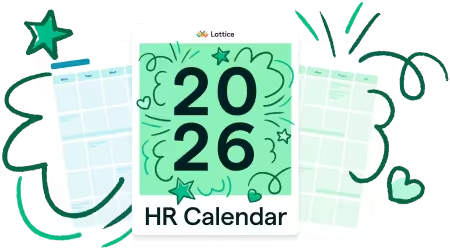Paternity Leave Policy Template


Download this template for free
By submitting your information, you agree to Lattice's Terms of Service and Privacy Policy. You can opt out anytime.
Thanks! We'll be in touch soon.
Welcoming a new child is a major life event — not just for birth parents, but for all caregivers. A thoughtful and inclusive paternity leave policy recognizes the role that fathers and non-birth parents play in caregiving, bonding, and supporting their families.
Providing paid paternity leave helps normalize caregiving for all genders, promotes equity in the workplace, and shows employees that they don’t have to choose between career and family. This policy outlines how paternity leave works, who is eligible, and how to request time off during this meaningful time.
What the Paternity Leave Policy Should Include
A strong paternity leave policy should clearly explain:
- Purpose and scope: Why the policy exists and who it applies to
- Eligibility: Which employees qualify (e.g., fathers, partners, adoptive or foster parents)
- Length of leave: Paid and unpaid time off details
- Coordination with other policies: FMLA, state family leave, or parental leave policies
- How to request leave: Required notice and documentation
- Pay and benefits: What’s covered, what continues during leave, and how pay is handled
- Job protection: Assurance that employees can return to their role after leave
- Inclusivity and flexibility: Language and practices that apply to all types of families and caregiving structures
Purpose of the Paternity Leave Policy
This policy is designed to:
- Support employees who are welcoming a new child by birth, adoption, or foster care
- Promote gender equity in caregiving responsibilities
- Ensure consistency and clarity in how paternity leave is administered
- Provide flexibility and support during the transition to parenthood
- Comply with applicable state, local, and federal laws, including FMLA
Paternity leave is about care, bonding, and inclusion — and this policy ensures all parents feel supported from day one.
Sample Paternity Leave Policy
{{rich-highlight-1}}
Effective Date: [Insert Date]
Policy Owner: People Team / HR Department
Last Reviewed: [Insert Date]
1. Policy Overview
[Company Name] supports all parents in caring for and bonding with their new child. This paternity leave policy provides time off to eligible employees who become a parent through birth, adoption, or foster placement. It is gender-neutral and applies to any employee assuming a caregiving role as a non-birth parent.
2. Eligibility
Employees are eligible for paternity leave if they:
- Are full-time or part-time employees
- Have worked at [Company Name] for at least [insert period, e.g., 6 months]
- Are a non-birth parent welcoming a child through birth, adoption, surrogacy, or foster care
- Will assume primary or shared caregiving responsibilities
Temporary, contract, or intern roles may not be eligible for paid leave but may qualify for unpaid time off, depending on local laws.
3. Length of Leave
Eligible employees are entitled to:
- [Insert number, e.g., 6 weeks] of paid paternity leave, to be taken within [e.g., 12 months] of the child’s arrival
- Leave may be taken all at once or split into two or more blocks (with manager and HR approval)
Additional unpaid leave may be available through the Family and Medical Leave Act (FMLA) or state-specific leave programs.
4. Pay During Leave
Paternity leave is paid at [100% of base salary] for the full duration of the leave period.
If an employee is also eligible for state benefits (e.g., Paid Family Leave), the company will coordinate pay to ensure compliance and avoid duplication.
All paid leave will run concurrently with applicable statutory leave unless otherwise required by law.
5. Requesting Leave
To request paternity leave:
- Provide written notice to your manager and HR at least 30 days in advance, when possible
- Complete the Paternity Leave Request Form (provided by HR)
- Submit documentation (e.g., expected due date or adoption confirmation, if applicable)
We understand that family situations may change. If you need to adjust your dates, we’ll do our best to accommodate.
{{rich-highlight-3}}
6. Benefits and Job Protection
While on paternity leave:
- Your job will be held, and you’ll be returned to your same or a comparable position
- You will remain enrolled in all benefits (health insurance, 401(k), etc.)
- The company will continue its share of benefits premiums; you are responsible for your portion
- Time away will not negatively affect performance reviews or promotion timelines
7. Return to Work
Returning from paternity leave can be a big transition. We’ll support you with:
- A re-onboarding conversation with your manager
- Flexibility for a phased return (e.g., reduced hours or remote days, when possible)
- Optional connection to parenting support groups or benefits resources
You’ll be asked to confirm your return date at least two weeks before the end of your leave.
8. Coordination with Other Leave Policies
Paternity leave is separate from:
- Sick leave or PTO (though PTO may be used to extend leave if desired)
- Maternity or disability leave (for birth parents)
- FMLA, which provides job-protected unpaid leave and may run concurrently
If you’re unsure how leave policies apply to your situation, HR is here to help you navigate your options.
9. Inclusivity and Family Structures
[Company Name] recognizes that families come in many forms. This policy applies equally to:
- Biological and adoptive fathers
- Partners in same-sex or gender-diverse relationships
- Legal guardians, step-parents, and foster parents
- Non-birth parents in surrogacy arrangements
We strive to use inclusive, gender-neutral language and offer equitable support to all new parents.
Frequently Asked Questions
1. Do I have to take my leave all at once?
Not necessarily. You may request to split your leave into multiple segments. This must be approved by HR and your manager and taken within 12 months of the child’s arrival.
2. Can I use PTO to extend my leave?
Yes. You can combine PTO with your paternity leave if approved. Some employees also choose to return part-time for a transition period.
3. What if my partner also works at the company?
Each eligible employee is entitled to their full leave benefit, regardless of whether their partner is also employed here.
4. Will my role or pay be affected if I take leave?
No. Your role, level, and compensation will remain unchanged. Using leave does not impact performance evaluations or promotion opportunities.
5. Can I take paternity leave for foster or adoptive children?
Yes. Paternity leave is available for any new child joining your family, regardless of biological relationship.
{{rich-highlight-2}}
🚩 Please note: This sample policy is for informational purposes only and does not constitute legal advice. It is a generic template that may not suit your specific circumstances. When adopting or revising a policy, consult legal counsel to ensure compliance with applicable laws and regulations.
✨ Disclaimer: This resource was developed with the help of artificial intelligence, though reviewed, edited, and approved by (real) humans.
Frequently Asked Questions

Your people are your business
Ensure both are successful with Lattice.





.webp)